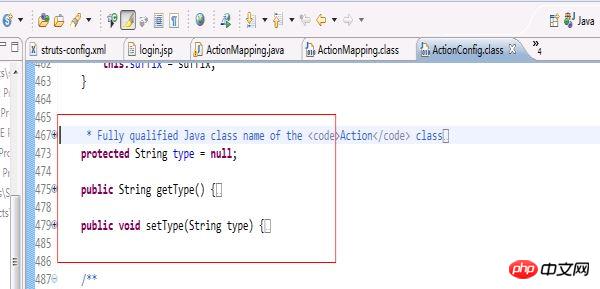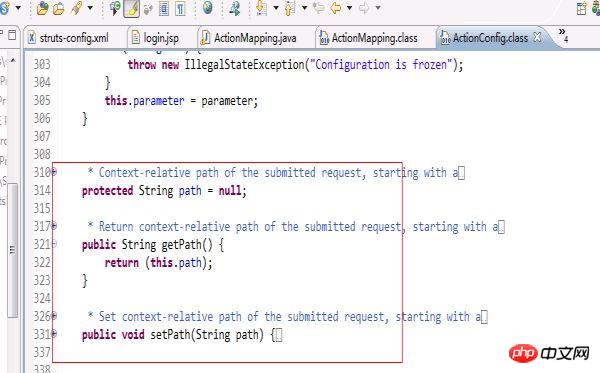Rumah >Java >javaTutorial >Struts1之ActionMapping实例讲解
Struts1之ActionMapping实例讲解
- 巴扎黑asal
- 2017-09-06 09:34:421754semak imbas
这篇文章主要介绍了Struts1教程之ActionMapping,小编觉得挺不错的,现在分享给大家,也给大家做个参考。一起跟随小编过来看看吧
首先断点走出了processpath方法,

这个方法是用来截取字符串的,今天我们来看怎样获得ActionMapping的方法---processMapping。
在此之前简单说一下ActionMapping,它的源代码中可以看出,其中最重要的属性和我们的mvc小实例中的ActionMapping类似,都是有path、type还有forwardMap,主要是对应的struts-config配置文件而来,这个就是保存这个配置文件的信息到内存中。
具体的mvc小实例的ActionMapping代码如下:
package com.cjq.servlet;
import java.util.Map;
public class ActionMapping {
private String path;
private Object type;
private Map forwardMap;
public String getPath() {
return path;
}
public void setPath(String path) {
this.path = path;
}
public Object getType() {
return type;
}
public void setType(Object type) {
this.type = type;
}
public Map getForwardMap() {
return forwardMap;
}
public void setForwardMap(Map forwardMap) {
this.forwardMap = forwardMap;
}
}而Struts中的Actionconfig(因为ActionMapping是继承这个ActionConfig的,所以我们来看ActionConfig更加直接)的代码如下:



从这两部分代码来看,更加印证了我在开篇写的mvc小实例是一个struts框架的雏形。
讲完ActionMapping的一些内容后,相信对ActionMapping有所了解,那么系统是如何生成ActionMapping和如何找到ActionMapping的呢?这就是今天要说的整体:
我们看下web.xml中有一个4781e2cbaa93c386271b418d3a01af0823065abc64b27fbca30c0905ab93e8ea0 配置信息,这个信息就是说明了但服务器已启动就动态读取struts-config配置文件把配置文件的信息put到ActionMapping中。所以当我们运行服务器的时候,我们在内存中已经存在对应struts-config配置文件信息对应的ActionMapping。今天就是要通过processMapping读取这个ActionMapping类。
进入断点调试,首先在processMapping方法上设置断点。

进入源代码中:
/**
* <p>Select the mapping used to process theselection path for this request
* If no mapping can be identified, createan error response and return
* <code>null</code>.</p>
*
* @param request The servlet request weare processing
* @param response The servlet response weare creating
* @param path The portion of the requestURI for selecting a mapping
*
* @exception IOException if an input/outputerror occurs
*/
protectedActionMapping processMapping(HttpServletRequestrequest,
HttpServletResponse response,
String path)
throws IOException {
// Is there a mapping for this path?
ActionMapping mapping = (ActionMapping)
moduleConfig.findActionConfig(path);
// If a mapping is found, put it in the request and return it
if (mapping != null) {
request.setAttribute(Globals.MAPPING_KEY, mapping);
return (mapping);
}
// Locate the mapping for unknown paths (if any)
ActionConfig configs[] = moduleConfig.findActionConfigs();
for (int i = 0; i < configs.length; i++) {
if (configs[i].getUnknown()) {
mapping = (ActionMapping)configs[i];
request.setAttribute(Globals.MAPPING_KEY, mapping);
return (mapping);
}
}
// No mapping can be found to process this request
String msg = getInternal().getMessage("processInvalid");
log.error(msg + " " + path);
response.sendError(HttpServletResponse.SC_NOT_FOUND, msg);
return null;
}首先我们传入我们在上一步截取的路径,通过moduleConfig的findAction方法来查找ActionConfig,并且返回ActionMapping。具体代码是:
ActionMapping mapping =(ActionMapping) moduleConfig.findActionConfig(path);
如果找到,那么就讲ActionMapping存放到request的context中。代码:
if (mapping != null) {
request.setAttribute(Globals.MAPPING_KEY, mapping);
return (mapping);
}如果没有通过path找到mapping,则在Actionconfig中遍历为未知路径寻找mapping,如果找到则存放到request中,如果没有找到,则返回错误信息,具体代码如下:
// Locate the mapping for unknownpaths (if any)
ActionConfig configs[] = moduleConfigfindActionConfigs();
for (int i = 0; i < configslength; i++) {
if (configs[i].getUnknown()) {
mapping = (ActionMapping)configs[i];
request.setAttribute(Globals.MAPPING_KEY, mapping);
return (mapping);
}
}
// No mapping can be found to process this request
String msg = getInternal().getMessage("processInvalid");
log.error(msg + " " + path);
response.sendError(HttpServletResponse.SC_NOT_FOUND, msg);
return null;来看下ActionServlet中的一个方法processActionForm,当我们在截取字符串,再根据字符串取得ActionMapping(这是前两篇文章中介绍的)之后,我们就要用利用ActionMapping来创建ActionForm了,并且把ActionForm放到request或session中管理。
先来看具体struts中processActionForm方法的具体实现:
/**
* <p>Retrieve and return the <code>ActionForm</code> associatedwith
* this mapping, creating and retaining oneif necessary. If there is no
* <code>ActionForm</code> associated with this mapping,return
* <code>null</code>.</p>
*
* @param request The servlet request weare processing
* @param response The servlet response weare creating
* @param mapping The mapping we are using
*/
protectedActionForm processActionForm(HttpServletRequestrequest,
HttpServletResponse response,
ActionMapping mapping) {
// Create (if necessary) a form bean to use
ActionForm instance = RequestUtilscreateActionForm
(request, mapping, moduleConfig, servlet);
if (instance == null) {
return (null);
}
// Store the new instance in the appropriate scope
if (log.isDebugEnabled()) {
log.debug(" Storing ActionForm bean instance in scope '" +
mapping.getScope() + "' under attribute key '" +
mapping.getAttribute() + "'");
}
if ("request".equals(mapping.getScope())) {
request.setAttribute(mapping.getAttribute(), instance);
} else {
HttpSession session =requestgetSession();
session.setAttribute(mapping.getAttribute(), instance);
}
return (instance);
}这个方法的大体流程是:根据ActionMapping中的name名称查找ActionForm,如果配置了ActionForm,那么就到request或session中查找,如果在request或session中存在已经创建的ActionForm,那么将返回。如果不存在那么会根据ActionForm的完成路径采用反射进行创建,再将创建好的ActionForm放到request或session中,之后返回ActionForm。
具体我们可以跟随断点调试来看看这个方法是如何运行的。
先设置断点,之后进入processActionForm方法。
第一个步骤就是创建ActionForm:
// Create (if necessary) a formbean to use
ActionForm instance = RequestUtils.createActionForm
(request, mapping, moduleConfig, servlet);
if (instance == null) {
return (null);
}通过调用RequestUtils.createActionForm的方法把ActionMapping中的ActionForm字符串生成对象,并且返回。进入这段代码中:
publicstaticActionForm createActionForm(
HttpServletRequest request,
ActionMapping mapping,
ModuleConfig moduleConfig,
ActionServlet servlet) {
// Is there a form bean associated with this mapping?
String attribute = mappinggetAttribute();
if (attribute == null) {
return (null);
}
// Look up the form bean configuration information to use
String name = mapping.getName();
FormBeanConfig config =moduleConfigfindFormBeanConfig(name);
if (config == null) {
log.warn("No FormBeanConfig found under '"+ name + "'");
return (null);
}
ActionForm instance = lookupActionForm(request,attribute, mappinggetScope());
// Can we recycle the existing form bean instance (if there is one)?
try {
if (instance != null && canReuseActionForm(instance,config)) {
return (instance);
}
} catch(ClassNotFoundException e) {
log.error(servlet.getInternal().getMessage("formBean",config.getType()), e);
return (null);
}
return createActionForm(config,servlet);
}方法首先定义变量name,并且从mapping中获取值,String name = mapping.getName();也就是我们实例中的LoginForm字符串。之后通过调用FormBeanConfig config =moduleConfig.findFormBeanConfig(name);这句话把相应的LoginForm字符串生成相应的对象。
这里要说明的是我们在struts-config配置文件中,配置过这样一个标签信息:
<form-beans>
<form-bean name="loginForm" type=".struts.LoginActionForm"/>
</form-beans>这个标签在服务器一启动的时候就会利用digester读取这里的配置信息,并且放在FormBeanConfig类中,这样我们可以通过上面那一句话就可以把LoginForm字符串生成相应的对象。
之后调用了ActionForm instance = lookupActionForm(request,attribute, mapping.getScope());这个方法,这个方法主要是查找scope属性中有没有存在ActionForm。具体实现:
if ("request".equals(scope)){
instance = (ActionForm)request.getAttribute(attribute);
} else {
session = request.getSession();
instance = (ActionForm)session.getAttribute(attribute);
}这里判断scope属性值是否为request,如果是则从request中读出ActionForm,如果不是则从session中读出。程序如果是第一次执行,那么ActionForm会是为空的。因为这里的ActionForm为空,所以就进入了if判断语句中,最后通过调用return createActionForm(config, servlet);创建ActionForm并且返回。
之后processActionForm就会把返回来的ActionForm放入request或者session中。具体实现就是:
if ("request".equals(mapping.getScope())){
request.setAttribute(mapping.getAttribute(), instance);
} else {
HttpSession session =request.getSession();
session.setAttribute(mapping.getAttribute(), instance);
}到此为止,ActionForm就创建完成,当ActionForm创建完成之后,就要用其他的方法来往ActionForm中赋值了
Atas ialah kandungan terperinci Struts1之ActionMapping实例讲解. Untuk maklumat lanjut, sila ikut artikel berkaitan lain di laman web China PHP!

